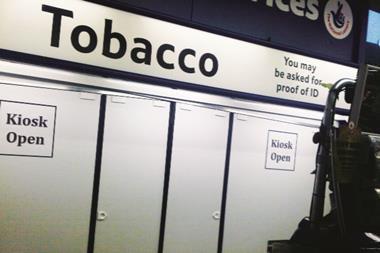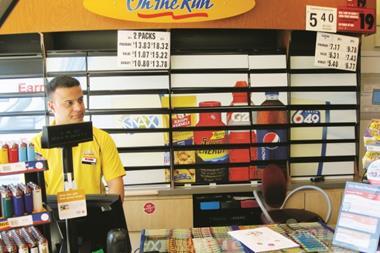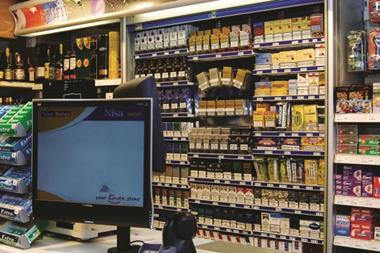Gaelle Walker explores the challenges facing retailers with large stores as April’s tobacco display ban draws near
In a little over two months, the way in which tobacco products are sold in UK stores will change for ever.
After almost four years of political wrangling and lobbying by the retail industry, a display ban is due to be implemented in large stores (3,000sq ft plus) in England this April.
However, despite the looming deadline, the absence of any final regulations means that large retailers are still (excuse the pun) in the dark about the exact changes they will need to make.
The government did shed a little light on the matter at the end of December when it finally published formal guidance, but it is important to note that it is just that: guidance. The 20-page document, which it says is “not intended to be definitive”, includes some clarification on requested displays and price lists. Yet it contains no hard and fast details on exactly what will count as a compliant solution and what won’t, simply stating that “retailers are free to choose for themselves the most appropriate and efficient means of removing tobacco products from sight” either by fitting covers, sliding doors, or even curtains.
The guidance also states that tobacco products can be kept on open shelves under or beside the counter, provided they cannot be seen by the public.
But with a £5,000 fine or six-month prison sentence for non-compliance, concrete details are urgently needed, particularly given the varying approaches that individual local authorities have to enforcement.
As C-Store went to press, the Scottish government announced it has scrapped the April deadline but set no new start date, and revealed that stores will have to work with a requested display area of 1,000sq cm - small, but larger than was originally feared. They will also face a £200 fixed penalty notice for each breach.
Wales and Northern Ireland have yet to lay their regulations before the EU, a fact which is likely to render the April 1 deadline for large stores here unworkable, too.
“If this happens, only large stores in England would be forced to comply with the ban from April resulting in massive confusion for retailers and shoppers,” says Association of Convenience Stores public affairs director Shane Brennan.
The long delays have also forced the UK’s tobacco manufacturers to drop their legal challenge of the legislation. A Judicial Review was due to be heard on February 6. However, just before Christmas Imperial Tobacco, JTI, BAT and Philip Morris informed the English High Court that they would not be continuing with it.
“The delays experienced in the English display ban regulations being put in place meant that we had no other alternative but to discontinue the challenge,” JTI UK managing director Martin Southgate said.
“We remain strongly of the view that display bans are ineffective, bad for retailers and will only put extra pressure on legitimate business when they least need it. Our focus now is in assisting the retail trade to adapt to this significant change to their businesses.”
At the time of going press, though, large retailers are reporting scant communication from gantry suppliers. Gloucestershire Budgens retailer Guy Warner said he still had no clear idea what type of solution would need to be fitted in his three large stores. “My gantry supplier has told me that it has a solution ready, but has given me no concrete details on how it will look, or work. With the deadline so imminent I would like to know more by now. It’s pretty concerning.”
On the positive side, Guy has been reassured that his supplier will fund the necessary changes, although whether this will be the case for all large stores remains to be seen. Guy adds: “I’ve also looked at electronic kiosks as seen in the Republic of Ireland. They are an interesting concept as they wouldn’t impact on service times too much, would help to reduce shrinkage, and they look quite professional. However, they are costly so I’d have to weigh it up. It depends on what my suppliers’ solution looks like.”
Fellow Budgens retailer Vince Maloney, who owns an 8,000sq ft store in Ascot, Berkshire, also has only a shadowy idea of the exact changes that will need to be made to his store. “JTI changed the gantry a few weeks ago in readiness for the ban and I’ve noticed that it has some runners along the bottom and in the sides, which I imagine have been designed to accommodate sliding doors, although I’m not certain,” he says.
Judging by a trial being carried out in Tesco’s Market Harborough store, where light grey sliding doors have been retrofitted over the gantry, sliding doors look to be the most likely solution.
But it’s not just design that is concerning retailers. The lack of solid guidance on the length of time that sections of the gantry can be left open for restocking or requested displays is also troubling. The guidance states that the display should be open for “no longer than is necessary to complete the task” and that the open display, in England at least, does not exceed 1.5sq m. Staff will also have to take care to verify shoppers’ ages before performing a requested display, as to show tobacco to someone under 18 will be classed as an offence.
One certainty is that a display ban will force ranges in large stores to be rationalised. Nisa retailer Kishor Patel, who is trialling a solution in his smaller stores, said the challenge of finding brands behind screened off displays would make it impossible to manage the magnitude of brands and variants currently sold.
“We simply won’t be able to work with the proliferation of brands and variants currently available. I’ll be removing slow sellers such as 10s, and some menthol variants,” Kishor says.
It’s also becoming clear that staff training is going to be a monumental challenge, leading some retailers - including Vince - to think about complying early, so that any glitches have been ironed out before the deadline.
Experience from Australia, where some retailers have reported it taking up to 17 seconds to locate a packet of cigarettes following a display ban, has led Imperial Tobacco to promise to provide UK retailers with laminated planograms to help staff locate cigarette packs quickly. Even so, delays will be inevitable as adult smokers question the covered up displays and quibble over price and availability.
“These days many adult smokers like to browse the gantry for price. When they can’t do that it will create delays while they ask staff to check prices for them. The constant opening and closing of the doors is also likely to slow things up,” adds Vince.
The lack of a ‘one size fits all’ solution for Costcutter’s store estate has forced its store development team to work on a store-by-store basis to ensure that each has the best possible solution, but even so, trading director Angela Barber agrees that service will be hit.
“The changes will inevitably lead to increases in the time it takes to stock the new units and to serve customers,” she says. About 10% of Costcutter’s store estate will have to comply with the April deadline, and Barber warns that the additional time taken stocking units will also impact on staffing hours “and could lead to increases in wage costs to ensure other areas of the business did not suffer”.
The impact on service times and customers’ experiences is worrying some large retailers so much that they are choosing to alter their stores in order to avoid complying with the 2012 enforcement dates.
Imperial Tobacco head of convenience Mike Laney told C-Store he knew of a few retailers with stores just over the 3,000 sq ft threshold who had reduced shop floor space in order to delay implementation until 2015.
Given the confusion surrounding this troublesome new law, you can hardly blame them. ■ I
PRICE LISTS
Once a display ban has been enforced it will also be illegal to display tobacco prices, except in the formats set out in the new law.
Only three types of tobacco price display will be permitted from the relevant dates:
● Poster lists (up to A3 in size) which can be left on show but limited to one per till point. Characters must not exceed 30 point size.
● A list, including pictures of products, which must not be left on permanent show,
but which can be shown to adult customers should they ask for it. Characters must not exceed 14 point size.
● Price labels, for shelving, storage units or tobacco jars. Each label must not be larger than nine square centimetres and characters must not exceed 14 point size.
All price lists or labels must be printed in black Helvetica font, in the same point size throughout.
All letters must be in lower case, except for first letters of words where appropriate. No underlining, italics, bold type or any other distinguishing emphasis is allowed. The background must be white.
The only information that can be given about tobacco products is:
● The brand name of the product
● The price of the product
● For cigars, the country of origin and size.




























No comments yet